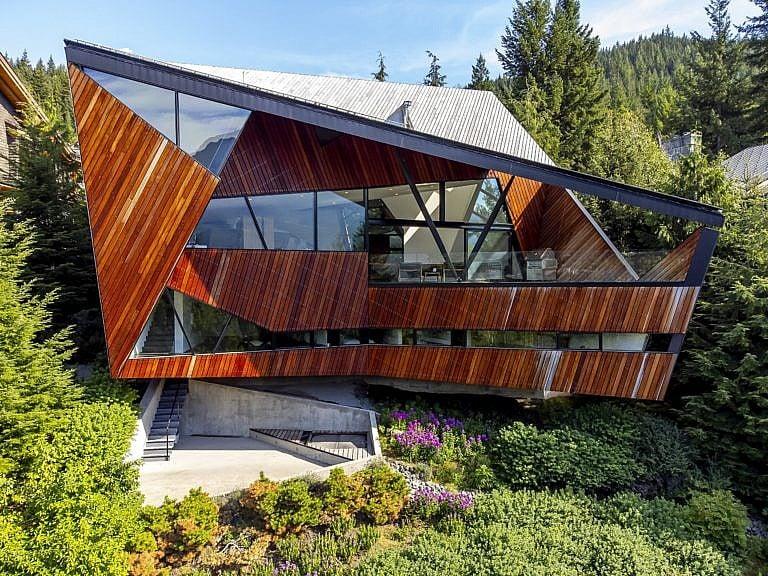For $12 million, you can live in this origami-style Whistler chalet
The Hadaway House, with its odd angles and award-winning design, is steps away from the ski hills

Share

In the Hadaway House on Whistler’s Sunridge Plateau, the exteriors and interiors fold into crisp angular shapes: the walls and ceiling lean, dip and rise through the home, rather than landing at right angles. The result looks like a giant origami chalet. “Often, things in there are off by five degrees,” says current owner Kenneth Ecker, who purchased the residence in 2021 with his wife. With its slanted doors and angular cave-like rooms, the interior of the house could easily fit into the world of Alice’s Adventures in Wonderland.
READ: Inside a funky Habitat 67 apartment on the market for $1.4 million
The vacation house, currently on the market for $12 million, is named after its commissioners, Martin and Sue Hadaway, a couple based in Hong Kong. In 2006, the Hadaways approached John and Patricia Patkau of the famed Vancouver-based firm Patkau Architects to design the house.

“Martin had one interesting personal requirement for the design,” John recalls, “and that was that the house could have no circular or curving forms.” So the Patkaus filled the interior with sleek angles, even having bathroom sinks custom-made to fit the specs. Without 90-degree corners, the builders had to figure out new ways to execute even the simplest tasks—such as taking measurements.
READ: A Manitoba five-bedroom fit for a (former) prime minister
“You can’t hold a tape measure up to where the height should be, because the walls are sloping and so are the ceilings,” John says. So they used lasers to measure the space, plus 3D modelling software to build the sophisticated parts of the house off-site.

Practical, rather than aesthetic, choices dictated the complex polygonal exterior of the house. The Patkaus had to design around the pie-shaped, steep land, and they also had to follow Whistler regulations surrounding property setbacks and neighbourhood regulations that mandate maximum building height and a wood-finished exterior. They chose to cover the roof and exterior walls of the house with Ipê hardwoord, otherwise known as Brazilian walnut, which will turn a silvery grey as it ages naturally over time.
The Patkaus also had to accommodate the extreme amounts of snow that fall in Whistler, which totals around 35.5 feet every year. So they came up with a steeply pitched roof that could deposit snow to the side yards, away from pedestrians. “Without a doubt, the architecture of the house was the biggest thing that drew us to buying the house,” Ecker says. He says that living inside the Hadaway House feels like living inside a hyper-modern museum. The interior is awash in large expanses of bare, white walls that reflect the sunlight, which in turn beam through oversized windows. “The house is not predictable; it’s exciting,” Ecker says.
READ: This modern home stands out in the Muskoka woods
Since he bought the place in 2021, Ecker has mainly upgraded the garage and technology around the house, such as thermostats, alarm systems and audio equipment. Workers had to be creative again in carrying out these upgrades, because the technology in the house hid behind walls. “There’s absolutely not a single amplifier that you can see,” Ecker says. Contractors had to cut out the drywall to reach these pieces of equipment and then repair the drywall afterwards.
The location was another thing that drew Ecker. Skiing is quite literally at the Hadaway House’s doorstep: he and his family just walk out their front door, tread 100 metres, and then climb up a flight of stairs to reach the Lower Olympic Run, a ski trail on Whistler Mountain.
READ: This tiny B.C. hut is a birdhouse for humans
After two years of owning the house, though, Ecker is ready to let it go. He and his family live in Vancouver, and the Hadaway House is a two-hour drive away. He feels they do not use the house enough; over the past 12 months, they have stayed in the house for fewer than 30 nights in total. “I don’t want to just own the house and have it sit there collecting dust,” Ecker says. “The house deserves to be lived in and appreciated.”